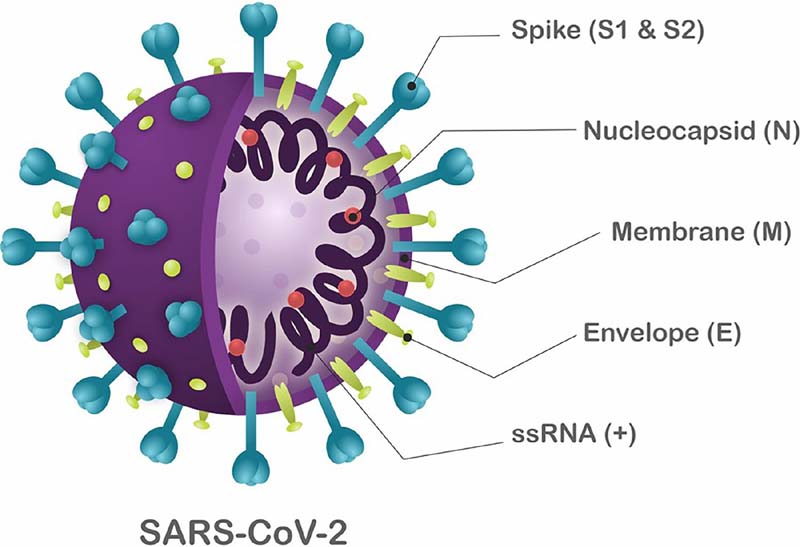NEW DELHI, Apr 6:
Scientists say that the contaminated sewage flowing through the sewerage system of the Huanan Seafood Market (HSM) could have played a role in advancing the high environmental presence of SARS-CoV-2 virus, leading its extensive distribution.
The scientists from the Chinese Center for Disease Control and Prevention (China CDC), China, along with those from other institutes, say that one of the possibilities included infected people and/or animals in the market contaminating the sewage.
They are part of a team investigating the potential introduction of SARS-CoV-2 to the market and have published their findings in the journal Nature.
They also found that none of the animal samples, including those from stray animals at the market, tested positive for the virus.
Human cases with COVID-19 were first reported in late December 2019, in Wuhan, China, as pneumonia of unknown etiology (PUE).
While there have been multiple research papers published on the origins of SARS-CoV-2, the origins and the role of the Huanan Seafood Market (HSM) in the origins and spread of SARS-CoV-2 remain unclear.
The current research on the data from the HSM could provide important information, the scientists said in the study.
Located in the Jianghan District in the downtown area of Wuhan, the capital city of Hubei Province, China, and occupying an area of more than 50,000 square metres (sqm), the HSM has 678 stalls located close to each other under extremely crowded conditions.
10 of these 678 stalls, identified as per sale records to have sold domesticated wildlife, were located in the south-western corner of West Zone (8 out of 10) and north-western corner of East Zone (2 out of 10), which are zones into which the HSM is divided. Seafood and animals mainly were sold in the West Zone and livestock meat in the East Zone.
Analysing sale records of late December 2019, it was found that a range of animals including snakes, avian species (chickens, ducks, gooses, pheasants and doves), rabbits, giant salamanders were sold in these 10 stalls, among which snakes, salamanders and crocodiles were traded as live animals.
The market was closed on the morning of January 1, 2020, shortly after the identification of the PUE.
From that day until March 2, 2020, as part of investigating the potential introduction of SARS-CoV-2 to the market, a total of 923 environmental samples from within and around the market and 457 animal samples, including dead animals in refrigerators and freezers and stray animals and their feces, were collected. The goods inside the stalls were completely cleared and disinfected until early March 2020.
Of the 923 environmental samples, 73 (7.9 per cent) were RT-PCR tested positive for SARS-CoV-2.
Among the 828 samples taken inside the HSM, 64 (7.7 per cent) were positive.Of these 64 positive samples, 56 were collected in the West Zone of the market from streets 1 to 8, with 40 of them (71.4 per cent) returning positive. Five out of 14 samples from HSM warehouses tested positive.
In the surrounding areas outside the HSM, 3 out of 51 samples from sewerage wells tested positive. 24 samples out of 110 collected from sewers or sewerage wells in the market returned a positive test. Further, all four sewerage wells in the market tested positive.
An on-site investigation of the HSM overground drainage pathway revealed that its wastewater led into the underground drainage inside the market, and then flowed into the wells on the edge of the market.
Following this, a spot-check sampling of all overground drains revealed a mixing of upper respiratory tract excreta of infected humans and potential animal waste.
The data from all these investigations, thus, suggested that either infected people and/or animals in the market contaminated the sewage or that the contaminated sewage may have played a role in furthering the virus transmission within the case cluster in the market.
Further, the study said that the detection of SARS-CoV-2 in multiple shops selling different product types suggested that SARS-CoV-2 may have been circulating in the market, especially the West Zone, for a while in December 2019, leading to an extensive distribution of the virus within the market.
The study also found that none of the 457 animal samples, which included samples from unsold goods kept in refrigerators and freezers in stalls, alive Chinese giant salamanders found in a fish tank and stray animals in the market (stray cat, cat faeces, a dog, a weasel and 10 rats), tested positive for SARS-CoV-2.
To determine the presence of live virus at the HSM, 27 SARS-CoV-2 positive environmental samples collected on January 1, 2020, were inoculated.
Virus isolation from original samples betrayed high amounts of the live SARS-CoV-2 virus in the HSM environment.
Further, a long environmental persistence of its genetic material was detected, which the scientists said could reflect high levels of environmental contamination before market closure.
Phylogenetic analysis, or analysis concerning the environmental evolution, revealed that environmental viral strains clustered together with the human strains.
The study summarised by saying that it could be possible that the market acted as an amplifier of viral transmission, causing many of the initially identified infection clusters in the early stages of the outbreak.
A majority of the early COVID-19 cases were found to be linked to the HSM and, thus, it was suspected to be the source of the COVID-19 pandemic.
The scientists said that not all of the early human cases could be epidemiologically linked to the market and alternative hypotheses for the market association, such as entry of virus into the market via humans or the cold-chain, also exist. (PTI)
Trending Now
E-Paper


